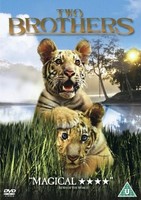
ean-Jacques Annaud transports us to the richly beautiful Cambodian jungle in the early 1920s , where two tiger cubs, Sangha and Kumal, are born to their stable and loving family unit. Their playful brotherly bond creates many adventures until violence and greed removes the two from the wild and forces them into the human domain for exploitation. Annaud uses the film as a vehicle to explore controversial issues surrounding animal rights. The tigers face cruel captivity, with Kumal kept imprisoned in the local circus and Sangha in a royal menagerie, both exploited for entertainment value. The cubs transform from playful, free-spirited and affectionate brothers into forced enemies, when the two tigers are encouraged to fight in a festival for royal delight. Annaud exposes the cruelty enacted upon animals at the hand of human greed, and reinforces the argument that animals are agents capable of love, affection and fear.
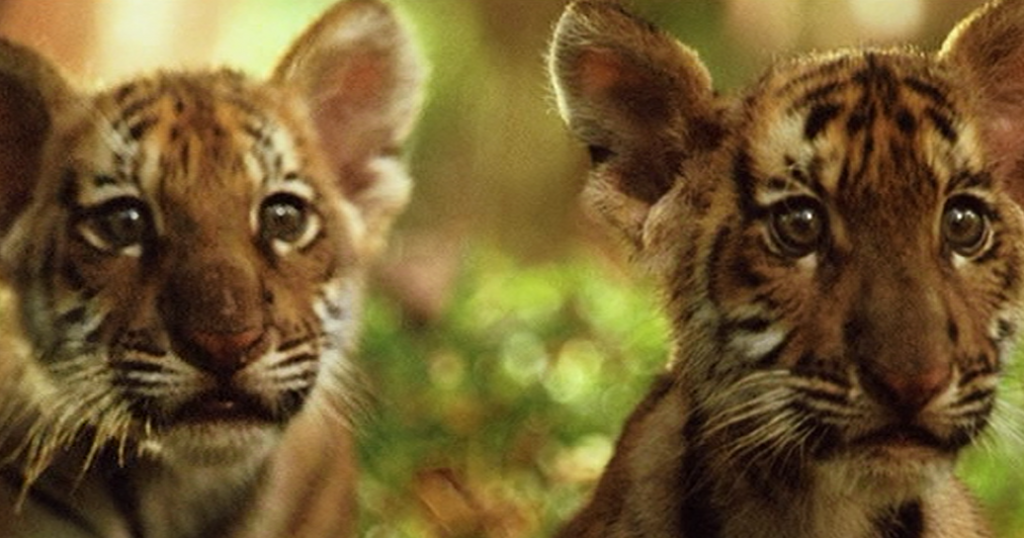
Two Brothers complies with Bouse’s Classical Model of a wildlife drama, similarly to Annaud’s The Bear. Sangha and Kumal are introduced at birth and the story follows their childhood in the beautiful Cambodian jungle, illustrative scenes of childhood play express their affectionate, brotherly bond. Annaud starts with their infancy to begin the inevitable narrative arc of their journey; their image as cute cubs ensures the tigers are perceived as vulnerable and endearing to gain our empathy. Kumal and Sangha are individualized using identifiable personality traits, one is fearless and the other tentative. In doing so the film provides the audience with recognizable characteristics to provide a point of relatability.
Following their infancy, the film tackles the ‘perils and trials of adolescence’; the two are ripped apart and forced into the human world of entertainment, providing the crisis in the narrative arc[1]. The audience becomes emotionally connected to our protagonists and yearn for the completion of Bouse’s archetypal narrative in reuniting the brothers in adulthood[2].By presenting animals in this way Annaud seeks to condemn human intervention in wild environments. Kumal and Sangha’s intense brotherly bond and strong connection validates the concept that animals are capable of rational and emotionally intelligent thought.
The wildlife drama focusses primarily on the rich and saturated aesthetic to represent an authentic portrayal of the Cambodian environment. The introduction of the film overwhelms the senses by bombarding the audience with greenery, sacred temples and the enhanced sounds of wildlife. This vision of paradise makes the tigers’ captive environments seem even more cruel and uncomfortable to watch. The audience appreciates the contrast and understands that an animal’s natural habitat exists outside of the human realm.
Annaud connects the animal and human world by embedding animal references throughout the film. In multiple scenes animals are present in background imagery to subtly remind the audience as to our constant interaction with animals. For example, poultry are briefly shown on camera, drawing attention to the meat industry and our dependency on animals for diet. The auction scene demonstrates further subtle references to animals, in the form of tusks and fashion. In mixing the two spaces Annaud tends to present animals as a commodity . Their bi-products are sold for human consumption, and the presence of furs and mounted elephant heads in human environments seems uncomfortable. The contrast between wild animals settled in the Cambodian jungle and conversely a product for human manipulation critiques human involvement in the wild. Annaud implies that the presence of wild animals within the human space is fundamentally unnatural.
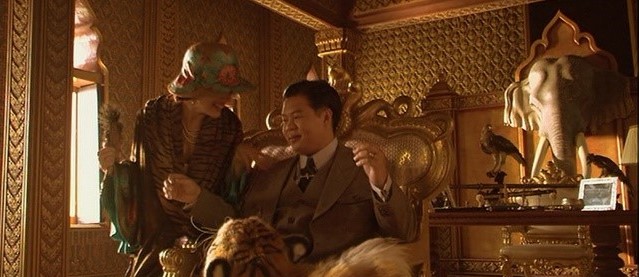
Two Brothers exposes acts of human violence against animals in industry, by pushing this image to the forefront of the film Annaud demands human responsibility and intervention. Sangha and Kumal are presented as victims of human greed and power. Influential characters (McCrory, Zerbino, the Prince) treat animals without dignity and disdain as they dominate the power struggle between humans and animals. This binary is made prevalent as human’s abuse animal rights for profit and entertainment succeeds respect for animal wellbeing. The binary is divided into villain and victim. A key moment in the film allows Annaud to explore this. As the tribe carries Kumal and Sangha’s father through the jungle the camera zooms onto the bloody image of the tiger hanging upside down on a spit, treated without dignity in his death. The loss of the father destabilises our relatable and beloved family unit, conclusively Annaud pressures the audience into rejecting the actions of mankind and aligning with the grieving animal family.
The film places emphasis on the immoral presence of animals within the entertainment industry and how captivity can cause ‘defeat and total subjugation’[3]. The circus demonstrates the power struggle between man and animal. The camera pans across the grimy cages at a high angle, marginalising the animals. Close-ups pay attention to their fearful eyes and their depressed conditions, a dark colour palette contrasts with the vibrant scenes of wildness and eerie music compliments the scene to emphasise this noxious space for wild animals. A stark distinction from the divine Cambodian jungle. Zerbino dominates the power struggle by repeatedly forcing Kumal to jump through a flaming hoop, Kumal’s personality has been manipulated from a strong and fearless tiger to that of an indoctrinated act. This scene is cathartic, Annaud uses a shot-reverse-shot sequence to show the fury of Zerbino and the fear expressed in Kumal’s eyes as he is pushed into the flames. Zerbino stabs him with a knife whilst the other circus animals scream and howl in emotional agony. The overwhelming use of imagery and sound heightens the catharsis in the scene and ultimately results in distress. The caged animals react in sympathy and fear, implying an emotional connection to Kumal. Kumal is part of this animal community, furthering Annaud’s argument that animals can develop relationships and possess emotional intelligence equal to that of humans. Our response to this scene aligns with the other animals, shocked and appalled we reject Zerbino’s actions in this scene, as it epitomises evil. Furthermore, the scene perpetrates guilt on the audience, we subconsciously link this circus to a multitude of organisations who use animals for entertainment, such as circuses, SeaWorld or zoos. Many of which we a guilty of supporting. Annaud presentation of animas demands self-reflection and understanding for animal suffering.
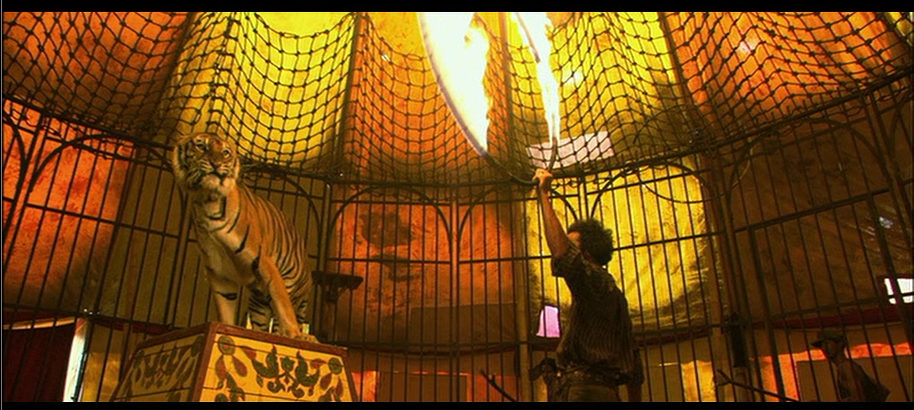
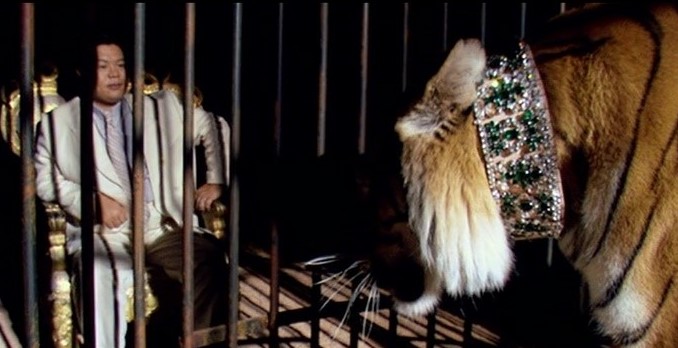
Annaud ensures that human presence within the film aligns itself to immorality whereas animal presence centres around innocence. The Prince embodies human greed and obliviousness, treating animals in terms of wealth and status. His mansion is embellished in animal décor, horns from shooting activities and photographs of successful hunts adorn the walls to fortify his status. The Prince captures wild animals in his Royal Menagerie. The camera uses Sangha’s point of view to navigate the menagerie; the camera provides close-up of predatory animals (hyenas, vulture, bears) held captive in miniscule cages and decorated in jewels and headdresses; the predators are stripped of their dignity. Sangha is forced into an expensive bejewelled collar for his bull fight, glamorizing cruelty and glorifying animal entertainment. This presentation of animals is fundamentally uncomfortable, previously majestic wild creatures have been disrespected to showcase wealth and status. The camera pauses on Sangha’s cage, Sangha stands in the only pool of natural light resembling a spotlight in a performance. This unnatural presentation suggests animals are not commodities for humans to exchange, deal or force into performance for our entertainment. Annaud guarantees that such treatment of animals is viewed as innately wrong using gothic imagery. The dark dungeon and firelight contribute to a sinister mise-en-scene and haunting animal cries strengthen the atmosphere.
The human/animal binary is crossed as a relationship develops between the tigers and their respective humans. Before Sangha is forced into the entertainment industry, he enjoys a domesticated relationship with Raoul. As Sangha cuddles close to Raoul (his motherly substitute) Annaud suggests a depth of emotion exists between the two, centring on trust and friendship. A portrayal of a positive human/animal relationship enables room for comedy within their shared space. For example, Sangha and Raoul play hide and seek together, Sangha outwits Raoul by hiding amongst his soft toys, camouflaging into the backdrop of Raoul’s bedroom. Sangha outsmarts Raoul, subverting the expected binary of animals and human, proving animals have instinctual intelligence equal to that of humans. Another moment of comedy arises when Sangha is chased through the house by Bittsi, the family dog. In the chaos, Sangha knocks over a fishbowl, the goldfish falls through the air and lands, swimming in a gentleman’s shoe. These moments of comedy allow for an endearing domesticized relationship. However, the chaos that ensues implies that Sangha does not belong within the domestic space. This second of humour is closely followed by a moment of realisation, and Sangha is ejected out of his new family unit due to his instinctually wild behaviour. Nevertheless, Raoul and Sangha’s connection outlasts the film promising a positive human/animal relationship based on trust and understanding.
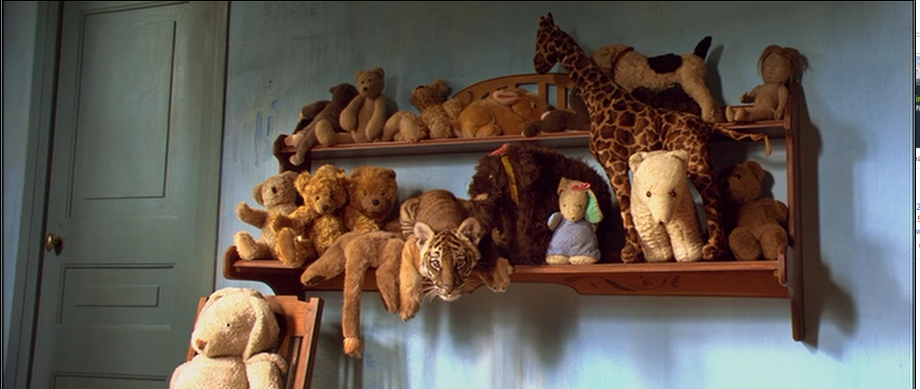
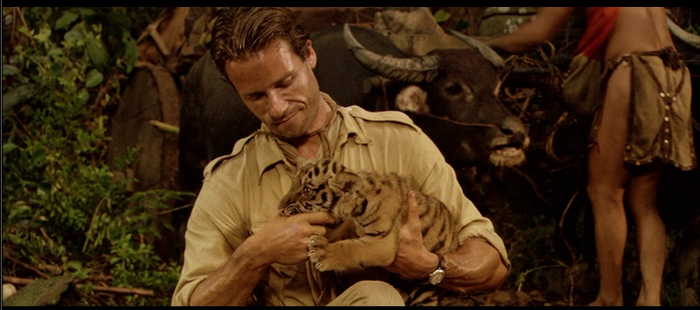
Annaud presents Kumal and McCrory’s relationship in parallel. An emotional connection between the two is unexpected. We associate McCrory’s occupation as a hunter with a disrespect for animal life. Despite this Kumal attracts McCrory and the two develop a level of understanding and respect. McCrory offers Kumal honey sweets, and this treat becomes a symbol of trust to reinforce their bond. The sweets are a point of recognition, allowing Kumal to acknowledge McCrory in the future, ensuring a lasting friendship. This presentation of animal-human relationships validates positive interaction between the two, proving animals to be agents capable of love and forming bonds with humans. By portraying a positive relationship Annaud provides a source of hope for human and animal interaction but insists that coexistence depends on respect and love between human and animals.
Annaud’s agenda for animal welfare is pursued by presenting animals as creatures capable of human emotion, culminating in the festival scene. The bull fight that takes place shows the two brothers, Sangha, vicious and aggressive, and Kumal, meek and fearful, pitted against each other for the audience’s entertainment. As the two fight Annaud captures the tension, the audience waits with bated breath as the brothers who previously enjoyed an unbreakable bond are forced to aggressively tear each other apart. The scene reaches its pivotal moment as Sangha aggressively pins Kumal down, but as the two look into one another’s eyes a moment of recognition sees the two rejoice in their reunion and begin to play fight as brothers. Annaud uses slow motion to emphasise its significance, that emotional and familial bonding prevails over violent and feral ‘animalistic’ behaviour. This moment of catharsis proves animals to have emotional intelligence and memory, their brotherly bond is stronger than the violent nature instilled in bull fights. The film flips the dynamic between animals and humans, the scene shows animals to be compassionate whilst humankind is exposed to be vicious and cruel. Tigers are presented as inherently predatory, their hunting characteristics and killing occurs only in terms of self-preservation. Contrastingly, humankind adopts feral characteristics expected of animals in negative and selfish ways. Their actions in the film are shown to be intrinsically cruel and result from greed. Viewers hope to align themselves with the compassionate animals, rather than Annaud’s spoilt and corrupt version of humankind.
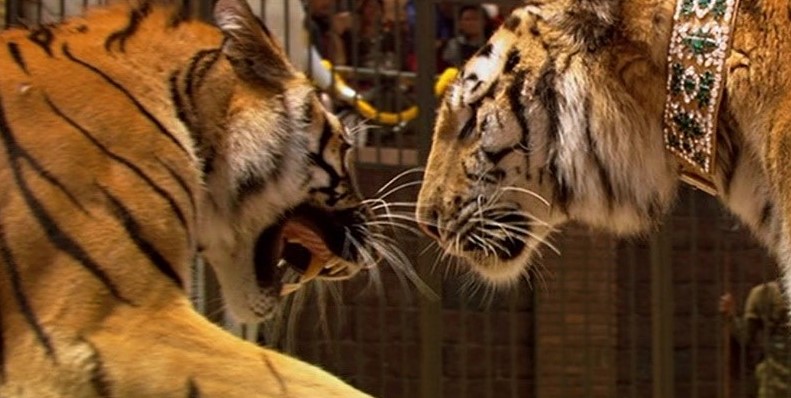
Two Brothers establishes itself as an emotionally engaging drama, similar to that of Disney’s Bambi or The Fox and the Hound, in which the infant animal must navigate the dangerous human world and seek its place in adulthood. Annaud chooses to present animals in such a way to provoke self-reflection and pleads for animal rights. His presentation of two identifiable tigers pushing through the cruel and inevitable narrative arc demands emotion from the audience and relatability to the animals. In Kumal and Sangha we see elements of hope, friendship, fear and love, all supposedly human emotions projected into the animal world. Here lies the crux of Two Brothers, Annaud’s point of relatability is our emotional hook. Our investment in their survival promotes animal welfare and critiques human abuse of the animal kingdom.
Bibliography/Suggested Further Reading:
Jean-Jacques Annaud, Two Brothers, Pathe Entertainment Productions, 2004
Jean-Jacques Annaud, The Bear, Renn Productions, 1988
Cowie, Helen. Exhibiting animals in nineteenth-century Britain: empathy, education, entertainment Basingstoke, Hampshire, Palgrave Macmillan 2014)
Stoner, Lynd., ‘Animals as Entertainment’, Education Database, Vol 103 (2013) p34
Bouse, Derek. Wildlife Films (University of Pennsylvania Press, Great Britain 2000)
Durov, V, My Circus Animals (London, Routledge, 1973)
Tait, Peta. Wild and dangerous performances: animals, emotions, circus (Basingstoke, Palgrave Macmillan 2012)
Dixon, Beth. ‘Animal Emotions’ Ethics and the Environment, Vol 6 (2002) pp22-30
Film Trailer: https://www.youtube.com/watch?v=xvRZIAwkTvQ
[1] Derek Bouse, The Classic Model, Wildlife Films, (Great Britain, University of Pennsylvania Press 2000) p131
[2] Derek Bouse, The Classic Model, Wildlife Films, (Great Britain, University of Pennsylvania Press 2000) p127
[3] Lynda Stoner, ‘Animals as Entertainment’, Education Database, Vol 103 (2013) p34